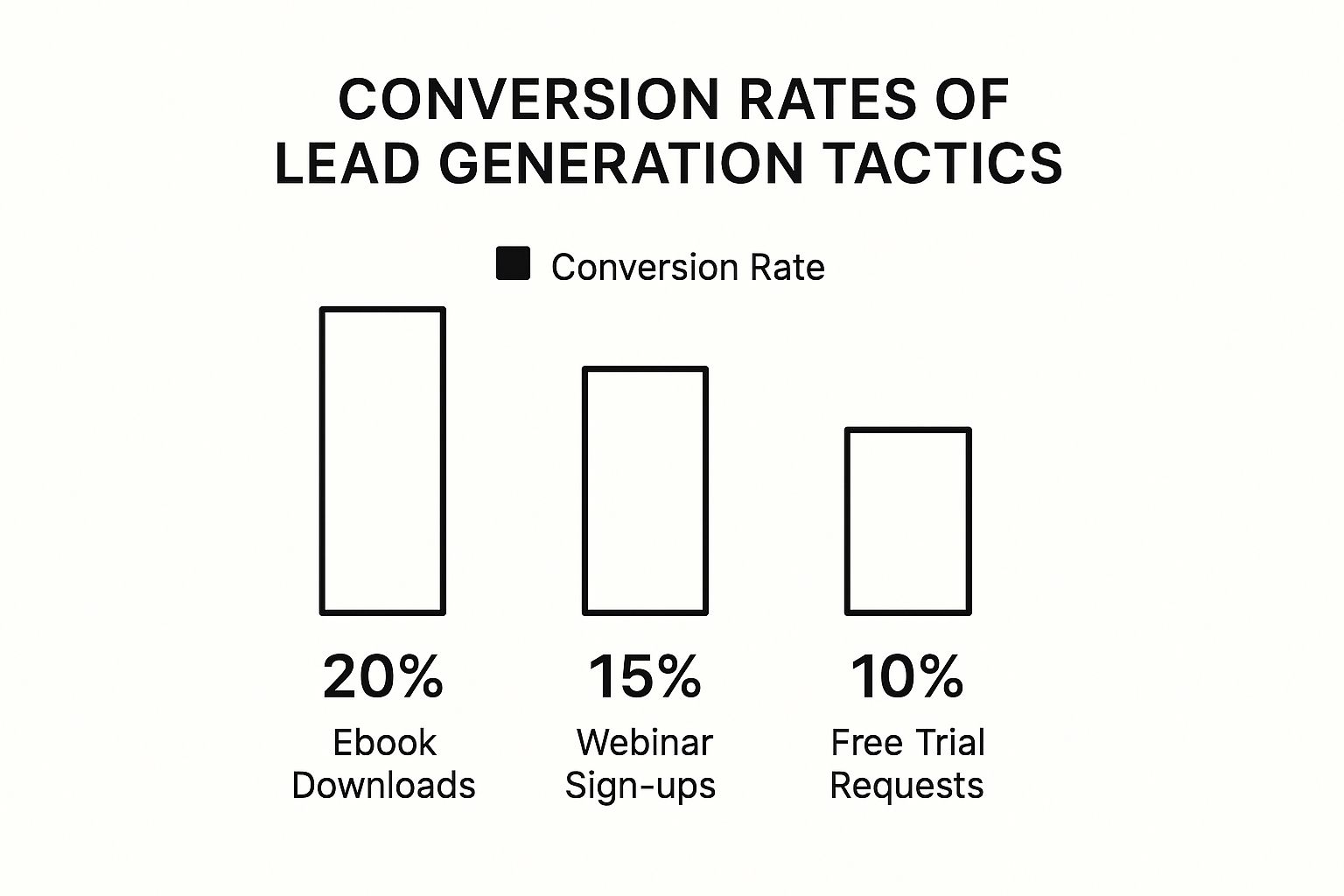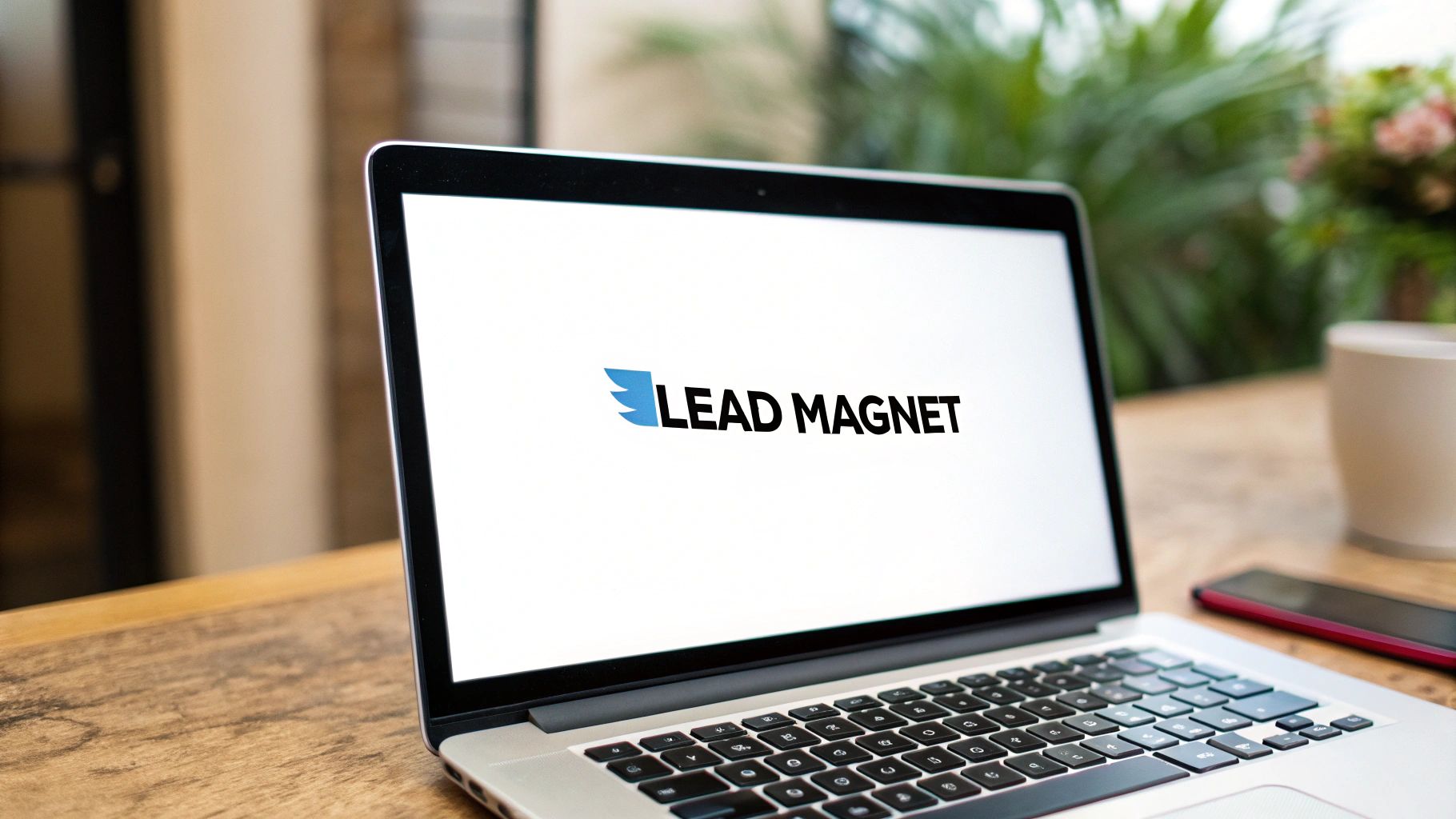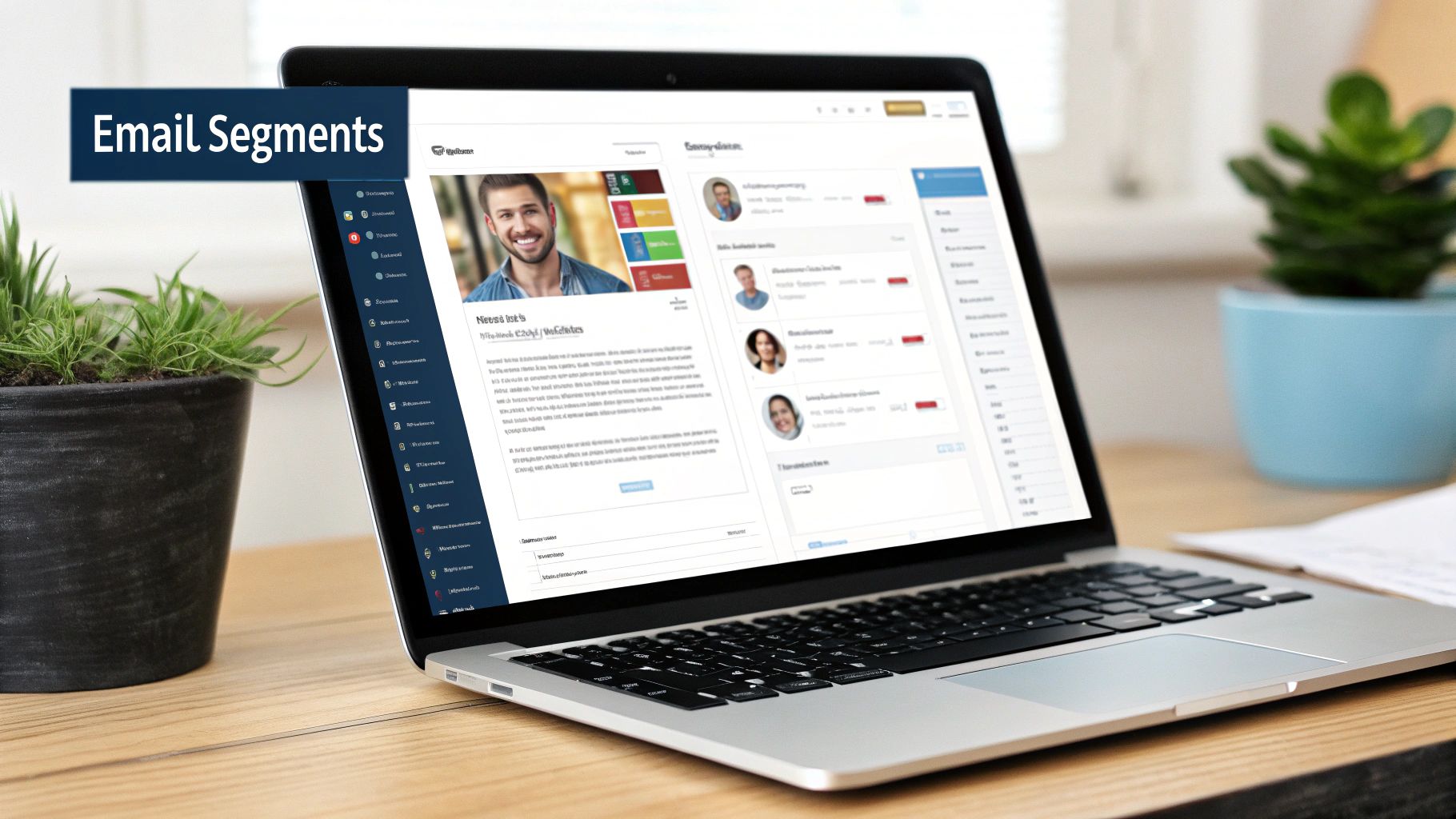Generating high-quality leads for your email marketing isn't about casting a wide net and hoping for the best. It’s a craft. It’s about building a system that consistently attracts the right people and gives them an undeniable reason to say, "Yes, I want to hear more from you."
This process hinges on creating genuinely valuable resources—what we call lead magnets—and presenting them through well-placed opt-in forms.
Building a Foundation for High-Quality Leads
Before you even think about pop-ups or landing pages, you need a solid game plan. Great lead generation isn't an accident; it's the result of a deliberate strategy designed to pull in prospects who are truly interested in your solutions. This groundwork is what separates a dead email list from one buzzing with engaged, potential customers.
The first move is always the most important. It’s about thoughtfully building an email list from the ground up, not just hoarding email addresses.
Define Your Ideal Subscriber
You can't hit a target you can't see. Who are you really trying to reach? Before you write a single word, get crystal clear on your ideal subscriber profile.
What keeps them up at night? What are their biggest professional frustrations or personal aspirations? When you understand what truly drives them, you can create offers and messaging that feel like they were made just for them.
Think about it this way: a business coach helping new freelancers could offer a generic "business tips" guide. Yawn. Or, they could create a "Freelancer's First 90-Day Client Acquisition Checklist." See the difference? The second option hits a specific, urgent pain point and immediately positions the coach as an expert. That’s how you turn a casual browser into an excited new subscriber.
Craft an Irresistible Lead Magnet
Your lead magnet is the heart of the transaction. It's the valuable asset you offer in exchange for an email address. Its sole purpose is to solve a specific problem—fast. The more precisely it targets a need and the more value it provides, the more people will sign up.
Some of the most effective lead magnets I've seen include:
- Checklists or Cheatsheets: Simple, scannable, and incredibly useful for helping people complete a task.
- Ebooks or Whitepapers: Deeper dives that establish you as a thought leader on a complex topic.
- Webinars or Workshops: Live or on-demand training that showcases your expertise in a dynamic format.
- Templates or Scripts: Done-for-you resources that save your audience a ton of time and effort.
A truly great lead magnet delivers more than just information; it provides a quick, tangible win. When someone uses your template and immediately sees a positive outcome, your credibility skyrockets.
And the data doesn't lie. Email marketing is a powerhouse, with nearly half (48%) of all marketers naming it their number one tactic for lead generation. The ROI is staggering, too—averaging an incredible $36 for every $1 spent. It's no surprise that 79.1% of marketers pair their opt-in forms with lead magnets to supercharge their conversion rates.
As the chart shows, in-depth resources often pull in the highest conversion rates because they promise a comprehensive solution to a significant problem.
Choosing the right lead magnet can feel overwhelming, so I've put together a quick comparison to help you match an offer to your specific audience and resources.
Choosing the Right Lead Magnet for Your Audience
This table compares different lead magnets, their ideal use case, and the effort required, helping you select the perfect offer to attract your target subscribers.
| Lead Magnet Type | Best For | Target Audience | Creation Effort |
|---|---|---|---|
| Checklist/Cheatsheet | Providing quick, actionable steps | Beginners needing a simple guide to follow | Low |
| Ebook/Whitepaper | Establishing deep authority on a complex topic | Professionals seeking in-depth knowledge | High |
| Webinar/Workshop | Demonstrating expertise and engaging visually | Learners who prefer live interaction or video | Medium |
| Template/Script | Saving the audience time and effort | Busy professionals looking for a shortcut | Medium |
| Quiz/Assessment | Personalizing the user experience and segmenting leads | Anyone curious about their own status or knowledge | Medium |
| Email Course | Nurturing leads over several days with bite-sized content | Subscribers who prefer learning in small, digestible steps | Low to Medium |
Ultimately, the best lead magnet is one that you can create well and that directly addresses a burning need for your audience. Start with what you know best and what you think will provide the most immediate value. You can always test and create more later.
Designing Forms and Landing Pages That Capture Leads
Your lead magnet might be incredible, but it's the design of your sign-up form and landing page that actually seals the deal. This is where a curious visitor makes the leap to becoming a lead. Think of it as the digital handshake—it needs to feel easy, trustworthy, and worth their time.
I’ve seen businesses pour money into ads only to fall flat at this final hurdle. The truth is, small design tweaks can lead to huge jumps in conversions. It's a game of psychology and user experience, and getting it right is fundamental to generating leads for your email marketing efforts.
The Anatomy of a Form That Converts
Your sign-up form isn't just a box to collect data; it's a micro-sales pitch. You have about three seconds to convince someone that handing over their email address is a fantastic idea.
Here's what I've found works every time:
- A Headline That Hooks: Never, ever just say "Subscribe." Instead, focus on the result. Something like, "Get 5 Actionable SEO Tips Sent to Your Inbox Weekly" immediately tells them what’s in it for them.
- Quick, Punchy Benefits: Use a few bullet points to spell out the value. What will they learn? What problem will you solve? Keep it brief and focused.
- Fewer Fields, More Leads: This is a golden rule. Only ask for what is absolutely essential. For most top-of-funnel offers, an email address is all you need. Every single extra field you add creates friction. In fact, research shows that cutting form fields from just four to three can boost conversions by a whopping 50%.
- A Call-to-Action with Personality: Ditch the robotic "Submit" or "Sign Up." Your CTA button should reflect the value they're getting. Try something exciting like "Send Me the Guide!" or "Unlock My Free Course."
Pro Tip: Make your CTA button pop. Use a color that contrasts sharply with the rest of your page's color scheme. This simple visual cue draws the eye and makes it completely obvious what you want the visitor to do next.
Landing Pages vs. On-Site Forms: Where Should Your Form Live?
You've got two main choices for placing your form: embedding it on your website or creating a dedicated landing page. Both have their place.
A dedicated landing page is a standalone page built for one thing and one thing only: capturing that email. There are no distracting navigation menus, sidebars, or other links. This intense focus is precisely why landing pages are conversion powerhouses, especially when you're driving traffic from ads or social media.
On the other hand, on-site forms (like in a blog post footer, a sidebar, or a pop-up) are great for catching visitors while they're already browsing your content. If you're wondering how to weave these into your site design effectively, getting the basics right is key. You can learn more about how to build a website designed for strong lead capture.
So, which one is better? Honestly, you should use both. Your dedicated landing pages will be your primary conversion machines for campaigns, while well-placed on-site forms will consistently turn your organic traffic into subscribers.
Driving Targeted Traffic to Your Opt-In Forms
You’ve built the perfect landing page and a killer opt-in form. Great. But if no one ever sees it, it’s just a pretty page collecting digital dust. The real work begins now: driving a steady, consistent flow of the right people to your offers.
This isn’t about just throwing money at ads and hoping for the best. It’s about building a smart traffic ecosystem. You want multiple channels working together, each sending qualified prospects who are genuinely interested in what you have to say.
Your mission is simple: get your lead magnet in front of the exact people who need the solution it provides. This calls for a mix of strategies—some that pay off today and others that will build your business for years to come.
Attract Organic Traffic with Content and SEO
Content marketing is your long-term powerhouse for lead generation. Think of it as building an asset that works for you 24/7. When you create high-value blog posts, in-depth guides, or helpful videos that directly address your audience's pain points, you naturally attract them through search engines like Google. These aren't cold visitors; they’re people with real intent.
Let’s say your lead magnet is a "Product Launch Checklist for E-commerce Brands." A perfect piece of content to support this would be a blog post titled "10 Common Mistakes to Avoid When Launching a New Product."
Inside that article, after detailing the pitfalls, you can seamlessly offer your checklist as the ideal tool to help them execute a flawless launch. It's the next logical step.
This creates a beautiful, self-sustaining loop:
- You solve an immediate problem with your free content, establishing trust.
- You offer a deeper solution with your lead magnet, making it an easy "yes."
- You build your email list with highly engaged leads who already view you as an expert.
This strategy is foundational. It brings in warm leads who are already looking for answers, making them far more likely to subscribe and eventually buy.
Generating leads is a top priority for most marketers—in fact, 50% say it's their primary focus. The average cost per lead hovers around $198, which is why smart marketers lean on more efficient channels. Content marketing is used by 76% of them, and social media by 68%, to bring those costs down.
Use Paid Ads for Immediate, Targeted Reach
Organic traffic is a marathon, not a sprint. While it builds momentum over time, paid advertising gives you instant, laser-focused reach. Platforms like Google, Facebook, and Instagram are powerful because they let you zero in on your ideal customer with incredible precision. You can target based on their interests, demographics, online behavior, and more.
This is exactly what you need to get a new lead magnet off the ground.
For example, you could run a highly targeted Facebook ad campaign that sends people directly to the landing page for your e-commerce checklist. For those with a well-defined customer avatar, our guide on https://www.sugarpixels.com/ecommerce-ppc-marketing/ offers a solid framework for turning ad dollars into a list of eager subscribers.
A well-crafted ad campaign can provide a predictable stream of new leads from day one. To dig even deeper, learning the ins and outs of generating high-quality PPC leads is crucial for making your ad spend work smarter, not harder.
Crafting a Welcome Sequence That Builds Relationships
The moment someone hands over their email address is your golden opportunity. This is when their interest is at its peak and they're genuinely excited to hear from you. Just sending a generic "Thanks for subscribing!" is a huge mistake—it wastes the most engaged moment you'll ever have with that person.
Instead, you need an automated welcome sequence. This isn't just one email; it's a carefully planned series designed to kick off a real relationship from day one. You’re not just delivering a PDF; you're turning a new lead into an engaged fan of your brand.
Your First Email Sets the Tone
That very first email is everything. It frames the entire relationship moving forward. You absolutely have to nail three things right away:
- Deliver the Goods: Get that lead magnet they signed up for into their hands instantly. No delays, no extra hoops to jump through.
- Welcome and Confirm: Offer a warm, genuine welcome. Briefly reintroduce your brand and remind them why they're here.
- Set Expectations: Be upfront about what kind of content you’ll be sending and how often they can expect to hear from you. This simple step builds trust and drastically cuts down on future unsubscribes.
Getting this first touchpoint right is critical. A strong welcome email can lift open rates for every single message you send afterward. Think of it as the foundation of your entire email marketing strategy.
Map Out a Nurture Series That Connects
One email is a nice start, but it’s not enough. A multi-day sequence, dripped out over a few days, is where you really start to forge a connection and guide new subscribers deeper into your world.
Think of it like giving a tour of your home. The first email was the friendly hello at the front door. Now, you get to show them around. For some great practical ideas, digging into different lead nurturing email templates can give you a fantastic head start on building an effective sequence.
A great welcome series doesn't just sell—it serves. Its primary job is to provide so much value upfront that your new subscriber feels like they made an amazing decision by joining your list.
This approach is so effective because email is still a powerhouse for customer acquisition. In the B2B world, 73% of marketers see email as the most efficient channel for lead capture, and 59% point to it as their top revenue-generating channel. Those numbers prove just how vital it is to nail those first few interactions. You can find more data on the power of B2B email marketing on stripo.email.
A 3-Day Welcome Sequence Blueprint
To get you started, here is a structured plan for your welcome email series. Use this blueprint to outline the goal, content, and call-to-action for each message to effectively onboard new subscribers and make them feel right at home.
| Day | Email Goal | Key Content | Primary Call-to-Action (CTA) |
|---|---|---|---|
| 1 | Welcome & Deliver | Deliver the lead magnet. Share your brand story or "why." Set expectations. | "Download Your Guide" or "Access Your Template." |
| 2 | Provide Bonus Value | Offer an extra tip, a quick win, or a link to your most popular blog post. | "Read the Full Post" or "Watch This Quick Video." |
| 3 | Engage & Segment | Ask a simple question to encourage a reply. Share a powerful case study or success story. | "Reply and let me know…" or "See How They Did It." |
This simple three-day sequence accomplishes so much more than just onboarding. It kicks off a conversation, builds a foundation of trust, establishes you as an expert, and gives your new subscriber a taste of your brand's unique personality.
Gauging Success: How to Measure and Optimize Your Lead Generation Efforts
Here's a hard truth: launching your lead generation funnel is just the beginning. You can't just set it up and hope for the best. The real work—and the real growth—comes from a constant cycle of measuring, testing, and tweaking what you've built.
Think of yourself as a scientist in a lab. You start with a hypothesis about what your audience wants, run an experiment to test it, and then analyze the results. That data tells you what to do next. This is the exact mindset that separates a stagnant email list from one that grows month after month.
Track the Metrics That Actually Matter
Before you can improve anything, you have to know your numbers. But not just any numbers. Forget about vanity metrics that feel good but don't impact your bottom line. We need to focus on the data that tells the true story of your funnel's performance.
I always keep an eye on these three core metrics:
- Landing Page Conversion Rate: This is your ground zero. It's the percentage of people who hit your landing page and actually sign up. This number tells you, point-blank, how effective your copy, design, and offer are.
- Cost Per Lead (CPL): If you're running paid ads, this is non-negotiable. Simply divide your total ad spend by the number of new leads you got. It's the ultimate reality check on whether your campaigns are financially viable.
- Lead-to-Customer Rate: This one is about quality over quantity. What percentage of your hard-earned leads eventually buy something? This metric reveals if you're attracting window shoppers or genuine potential customers.
Watching these figures like a hawk allows you to diagnose problems fast. A plummeting conversion rate might point to a confusing headline. A sky-high CPL could mean your ad targeting is way off.
The entire point is to create a feedback loop where data drives your decisions. The numbers should tell you everything from which ad to run next to which benefit to feature on your landing page.
The Power of A/B Testing
Once you've got a handle on your baseline metrics, it's time to start improving them. The best way to do that is with A/B testing, also known as split testing. It’s a simple concept: you create two versions of a single thing (like a headline) and see which one your audience responds to better. No more guessing.
The golden rule of A/B testing is to only change one thing at a time. If you test a new headline and a new button color in the same experiment, you'll have no idea which change actually made the difference. Be patient and methodical.
Ready to get started? Here are some of the most impactful elements to test right away:
- Headlines: Try pitting a direct, benefit-focused headline against one that asks a provocative question.
- Call-to-Action (CTA) Text: Does "Download Now" work better than a more personal "Get My Free Guide"? Test it!
- Form Length: I've seen conversion rates jump just by removing one optional field, like asking for a first name. See if less friction means more sign-ups for you.
- Lead Magnets: This is a big one. Test two entirely different offers. Maybe your audience prefers a quick checklist over an in-depth ebook. You won't know until you test.
The little wins you get from these tests really add up. A 5% lift from a better headline, combined with a 10% boost from a punchier CTA, can dramatically increase your daily lead flow. This systematic process is the engine that drives sustainable growth for your email list.
Common Questions About Email Lead Generation
As you start wading into email lead generation, a few questions inevitably surface. I've heard them time and time again from clients. Getting these sorted out early on will save you a ton of headaches and help you build a much stronger strategy right out of the gate.
Let's clear up some of the most common ones.
Is It Better to Buy an Email List?
Let me be blunt: absolutely not.
I know buying a list feels like a tempting shortcut to a bigger audience, but it's one of the quickest ways to torpedo your entire email marketing program before it even sets sail. Think about it—these people never asked to hear from you. Your emails aren't just unexpected; they're spam.
Here’s the fallout I’ve seen from businesses that went down this road:
- Abysmal Engagement: Your open and click-through rates will be in the gutter. Why would they be anything else? The recipients have no clue who you are or why you're in their inbox.
- Sky-High Complaint Rates: People will smash that "mark as spam" button. This absolutely tanks your sender reputation with providers like Gmail and Outlook, making it harder for any of your emails to get delivered.
- Serious Legal Risks: Sending emails people didn't sign up for can land you in hot water with regulations like GDPR and the CAN-SPAM Act, and the fines are no joke.
The most valuable asset you have in email marketing is trust. You earn that trust when someone willingly gives you their email address—you can't buy it.
How Many Emails Should I Send?
The "perfect" frequency is a bit of a moving target—it really depends on your audience and industry. That said, a great starting point for most businesses is once a week. This keeps you on their radar without becoming inbox noise.
What matters more than the exact number, though, is consistency.
Don't bombard people with three emails one week and then disappear for a month. That’s just confusing. Whether you decide on a weekly, bi-weekly, or even monthly schedule, stick to it. You're training your audience to expect and even look forward to hearing from you.
What Tools Do I Really Need to Start?
You don't need a huge, complicated tech stack to get results. Honestly, you can get a lot done with just two core tools.
- An Email Service Provider (ESP): This is the one non-negotiable. Platforms like Mailchimp, ConvertKit, or beehiiv are built for this. They manage your contacts, help you create sign-up forms, and let you send automated campaigns. Crucially, they also handle the legal must-haves, like an unsubscribe link in every email.
- A Simple Landing Page Builder: Many ESPs have this built-in, but sometimes a dedicated tool gives you more power and flexibility. A good landing page provides a single, focused place to send traffic, which is key for getting people to sign up without distractions.
Start with these two. You can always layer in more advanced analytics or fancy design software as your list grows and your strategy matures. The most important thing is to get started and build some momentum.
At Sugar Pixels, we specialize in building the digital foundation you need to attract and convert high-quality leads. From designing high-converting landing pages to setting up your entire email marketing funnel, we handle the technical details so you can focus on building relationships with your new subscribers. Discover how our web design and marketing services can elevate your lead generation at https://www.sugarpixels.com.



